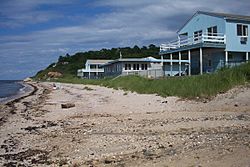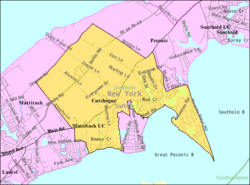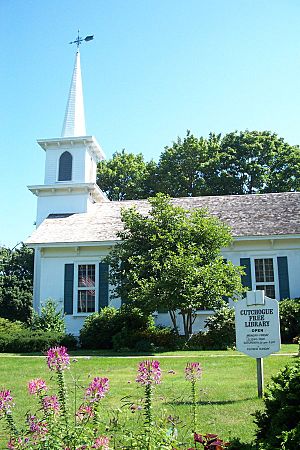Cutchogue, New York facts for kids
Quick facts for kids
Cutchogue, New York
|
|
|---|---|

Cutchogue waterfront on Long Island Sound
|
|
 |
|
| Country | United States |
| State | New York |
| County | Suffolk |
| Town | Southold |
| Area | |
| • Total | 10.94 sq mi (28.35 km2) |
| • Land | 9.78 sq mi (25.32 km2) |
| • Water | 1.17 sq mi (3.02 km2) |
| Elevation | 30 ft (9 m) |
| Population
(2020)
|
|
| • Total | 3,437 |
| • Density | 351.54/sq mi (135.73/km2) |
| Time zone | UTC-5 (Eastern (EST)) |
| • Summer (DST) | UTC-4 (EDT) |
| ZIP code |
11935
|
| Area code(s) | 631 |
| FIPS code | 36-19466 |
| GNIS feature ID | 0947961 |
Cutchogue (/ˈkʌtʃɒɡ/ KUTCH-og) is a small community located in Suffolk County, New York. It is on the North Fork of Long Island, which is a beautiful area known for its farms and vineyards. Cutchogue is considered a hamlet, which is a type of small village. It is also a census-designated place (CDP), meaning it's an area defined by the government for counting people. In 2020, about 3,437 people lived here.
The Cutchogue CDP generally covers the same area as the Cutchogue hamlet. Both are part of the town of Southold.
Contents
Geography of Cutchogue
Cutchogue covers an area of about 28.35 square kilometers (around 10.94 square miles). Most of this area is land, but a small part is water. The community is located on the Long Island Sound waterfront.
| Historical population | |||
|---|---|---|---|
| Census | Pop. | %± | |
| 2000 | 2,849 | — | |
| 2010 | 3,349 | 17.6% | |
| 2020 | 3,437 | 2.6% | |
| U.S. Decennial Census | |||
History of Cutchogue

The name Cutchogue comes from an old Algonquin word. It means "principal place," which suggests it was an important spot for the native people who lived here. Before English settlers arrived in 1640, many Native Americans lived at a place called Fort Corchaug.
One of the oldest buildings in New York State is in Cutchogue. It is called the Old House, and it was built around 1699. This house is a great example of early English building styles in the United States. It has even been named a National Historic Landmark.
Some famous people have connections to Cutchogue. Parker Wickham and his nephew John Wickham were important political figures in the 1700s. Also, the composer Douglas Moore (1893–1969) was born here.
In 1973, Hargrave Vineyard opened in Cutchogue. It was the very first winery on Long Island. Today, Cutchogue is also home to the Long Island Merlot Alliance. This group helps promote winemaking using the merlot grape, which is a main type of grape grown on Long Island.
Local Landmarks in Cutchogue
- Fort Corchaug: This is a 17th-century Native American settlement. It is also a National Historic Landmark.
- Wickham’s Fruit Farm: This farm has been run by the same family for hundreds of years, going back to the 1600s.
- The Cutchogue Diner: This vintage diner is housed in an original building from 1941. It was made by the Kullman Building Corporation.
- Cutchogue New Suffolk Free Library: The building that is now the library was originally a church. It was built in 1862.
- The Old House: Built around 1649, this is one of the oldest houses in New York state.
Population of Cutchogue
According to the census of 2000, there were 2,849 people living in Cutchogue. There were 1,120 households, with many of them being families. The community is mostly White, with smaller groups of African American, Asian, and Native American residents. About 5.69% of the population was Hispanic or Latino.
The population includes people of all ages. In 2000, about 21.5% of the people were under 18 years old. About 20.5% were 65 years old or older. The average age of people in Cutchogue was 44 years.
Albert Einstein and Cutchogue
The famous scientist Albert Einstein loved to sail. He once said that Little Peconic Bay in Cutchogue was "the most beautiful sailing ground I ever experienced." In the summers of 1938 and 1939, he rented a small house on Nassau Point. He spent many hours sailing alone in his small boat, which he called Tineff. Tineff is a Yiddish word that means "worthless." Even though he loved sailing, his skills were not always the best!
While in Cutchogue on August 2, 1939, Einstein had an important meeting. Two other physicists, Leó Szilárd and Edward Teller, visited him. They told him about new discoveries in nuclear physics. Szilárd had even created a nuclear chain reaction in a lab. Because of this, Einstein wrote a very important letter to President Roosevelt. This letter warned the President that Germany might be working on an atomic bomb. It also asked him to start his own program to research this. This letter is often given credit for starting the Manhattan Project. This was a big effort by the U.S. government to build the first atomic bomb.
When Szilárd first explained the idea of a nuclear chain reaction to him, Einstein famously replied, "Daran habe ich gar nicht gedacht!" This means, "I really never thought of that before!"
Schools in Cutchogue
Cutchogue is part of the Mattituck-Cutchogue Union Free School District.
See also
 In Spanish: Cutchogue para niños
In Spanish: Cutchogue para niños



